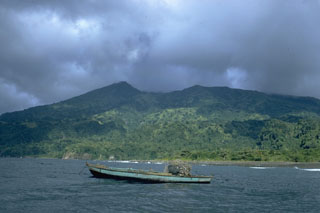Report on Soufriere St. Vincent (Saint Vincent and the Grenadines) — September 1979
Scientific Event Alert Network Bulletin, vol. 4, no. 9 (September 1979)
Managing Editor: David Squires.
Soufriere St. Vincent (Saint Vincent and the Grenadines) Lava extrusion continues
Please cite this report as:
Global Volcanism Program, 1979. Report on Soufriere St. Vincent (Saint Vincent and the Grenadines) (Squires, D., ed.). Scientific Event Alert Network Bulletin, 4:9. Smithsonian Institution. https://doi.org/10.5479/si.GVP.SEAN197909-360150
Soufriere St. Vincent
Saint Vincent and the Grenadines
13.33°N, 61.18°W; summit elev. 1220 m
All times are local (unless otherwise noted)
Extrusion of lava into Soufrière's summit crater continued through September. However, the rate of extrusion continued to decrease; the late August-late September rate was an order of magnitude less than peak values observed in mid-May.
Between 21 August and 23 September, the mean diameter of the lava body grew from 832 m to 840 m, covering about 60% of the crater floor, and its maximum height increased 1 m to 131 m. Its volume was calculated at 37.6 x 106 m3.
Small seismic events continued to be recorded by the summit seismograph. There has been no significant change in seismicity since a several-day increase in the number of events in late June and early July.
Geological Summary. Soufrière St. Vincent is the northernmost and youngest volcano on St. Vincent Island. The NE rim of the 1.6-km wide summit crater is cut by a crater formed in 1812. The crater itself lies on the SW margin of a larger 2.2-km-wide caldera, which is breached widely to the SW as a result of slope failure. Frequent explosive eruptions after about 4,300 years ago produced pyroclastic deposits of the Yellow Tephra Formation, which cover much of the island. The first historical eruption took place in 1718; it and the 1812 eruption produced major explosions. Much of the northern end of the island was devastated by a major eruption in 1902 that coincided with the catastrophic Mont Pelée eruption on Martinique. A lava dome was emplaced in the summit crater in 1971 during a strictly effusive eruption, forming an island within a lake that filled the crater. A series of explosive eruptions in 1979 destroyed the 1971 dome and ejected the lake; a new dome was then built.
Information Contacts: J. Tomblin, UWI.

